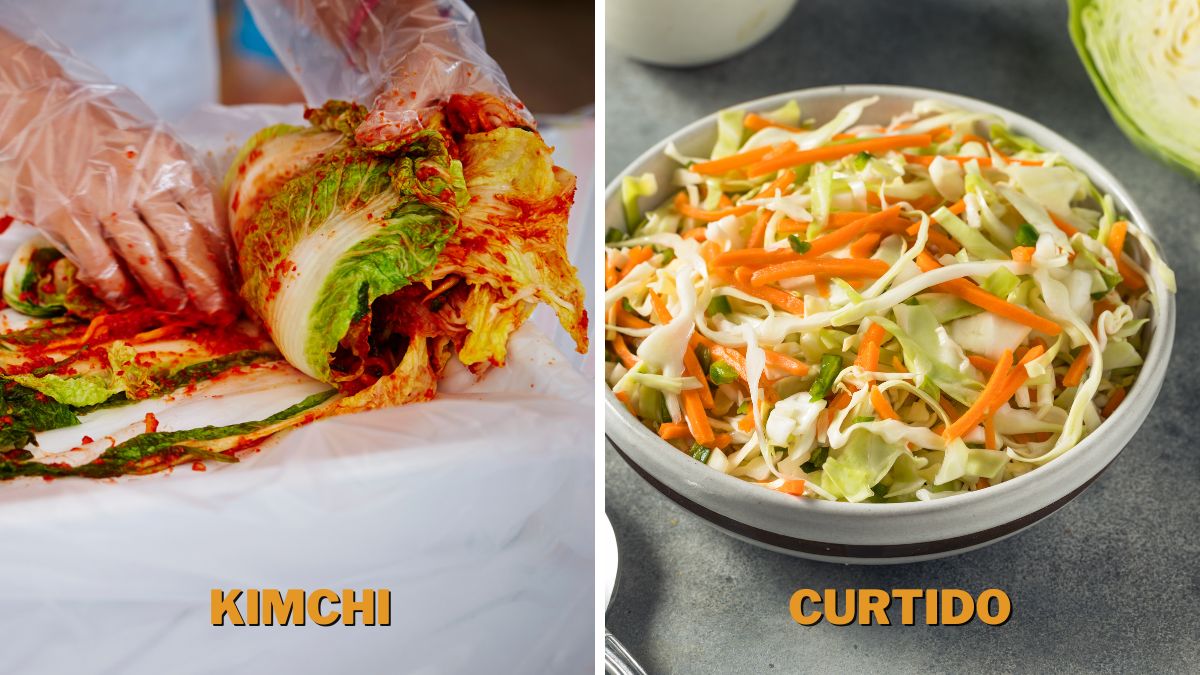Curtido vs. Kimchi: Differences Revealed

On the surface, curtido and kimchi seem quite similar – spicy, pickled vegetables popular in certain cultures. But after diving in and decoding the distinctions between these fermented favorites, I discovered they’re actually quite different. Both have unique origins, ingredients, preparation methods, tastes, and uses that set them apart. So, what are they?
Kimchi is usually served as a side dish in Korean cuisine, while curtido is used in Salvadoran cuisine. Kimchi is made with napa cabbage, radish, garlic, ginger, and chili pepper, while curtido contains cabbage, carrots, onions, oregano, vinegar, and chili peppers. Kimchi is fermented for days, while curtido is often eaten instantly.
For those curious to explore the world of fermented foods, understanding the nuances between kimchi and curtido is key. Join me as I share what I’ve uncovered in my quest to determine whether kimchi or curtido reigns supreme. The verdict may surprise you!
Curtido vs. Kimchi: Comparison
Curtido and kimchi may share some similarities as spicy pickled vegetables, but they have enough differences to remain distinct. As someone who enjoys exploring new flavors and cultural foods, I’ll make room in my fridge for both.
My love of cabbage and spices means curtido and kimchi are both welcome additions to my culinary repertoire.
Though they hail from different parts of the world, together, they showcase the human talent for transforming simple ingredients into delicious, complex, and memorable tastes. Let’s take a look at some of the differences between them:
The Roots of Kimchi and Curtido
Kimchi and curtido are both spicy, fermented vegetables used to add flavor and texture to dishes, but their origins differ quite a bit.
Kimchi originated in Korea, where fermenting vegetables has been an essential part of the culture for centuries, while curtido comes from El Salvador. Kimchi has been around for centuries and was developed as a way to preserve vegetables during the winter. The earliest known references to kimchi actually date back to around the 7th century.
On the other hand, curtido was created more recently, in the early 1900s, by Salvadoran immigrants looking to reproduce the spicy, fermented flavors of their homeland.
Ingredients and Preparation: What Goes Into Each Dish
Kimchi typically contains napa cabbage, garlic, ginger, chili peppers, scallions, and fish sauce or shrimp paste for flavoring. The ingredients are mixed together and packed into jars to ferment.
Curtido, on the other hand, uses green cabbage, onions, carrots, oregano, and lime juice. The chili peppers and spices used can vary but are usually milder than the Korean peppers used in kimchi. The veggies are shredded and fermented in a brine of water, salt, vinegar, or lime juice.

While kimchi can ferment for weeks or months, curtido usually only ferments for a few days. Kimchi also tends to be very spicy from the chili peppers, whereas curtido has more of a tangy and citrusy kick from the lime juice.
Contrasting the Tastes of Kimchi and Curtido
As a fan of fermented and pickled foods, I enjoy both kimchi and curtido, but I find they each have a unique flavor profile.
Kimchi typically has a spicier kick from the generous amounts of red chili pepper flakes, garlic, and ginger used. The heat builds up the longer it ferments. Curtido, on the other hand, is usually milder since it traditionally uses mild green chiles and omits the chili pepper.
I can eat curtido as a side to almost any meal, whereas kimchi pairs best with heartier, oilier foods that can stand up to its robust flavor.
Kimchi also tends to be more sour, with a lip-puckering tartness from ingredients like fish sauce or shrimp paste. curtido has a brighter, vinegar-like sourness from just lime juice. The lime and cabbage create a refreshing, crunchy, and sour slaw-like flavor in curtido.
Texture plays a role in the taste differences, too. Kimchi is often soft and limp from fermenting, whereas curtido maintains a satisfying crunch from the cabbage, carrots, and onions.
Uses in Cuisine
Both kimchi and curtido are commonly eaten as side dishes, used as toppings for dishes like tacos, or added to stews and soups. Regarding uses, kimchi is usually served as a side dish or condiment in Korean cuisine. Curtido, on the other hand, is more commonly used in Salvadoran cuisine as a topping for pupusas, tacos, or salads. Both can be found in some Latin American and Asian fusion restaurants as well.
Whether you prefer the heat of kimchi or the zest of curtido, both dishes are delicious examples of time-honored cultural traditions using fermentation to create flavor. I like to think of them as spicy and tangy cousins who prove that cabbage and fermentation are a winning combination globally.
Kimchi is also widely used in dishes like fried rice, pancakes, and jjigae stew. Curtido is more often used in Salvadoran specialties like pupusas, tamales, and yuca frita.
Overall, while kimchi and curtido are both spicy, fermented cabbage salads, their unique blend of ingredients, preparation, and cultural influences give each a distinct flavor profile and set of culinary uses. My taste buds can tell the difference, and I enjoy them both in their own right.
Key Differences Between These Fermented Foods
Regarding fermented foods, kimchi and curtido seem pretty similar at first glance. However, after sampling both, I’ve discovered some critical differences.
The base of both kimchi and curtido is napa cabbage, but kimchi typically contains garlic, ginger, red chili peppers, and fish sauce or shrimp paste for flavoring.
Moreover, kimchi preparation is quite elaborate, requiring the cabbage to be salted to soften and mixed with the spicy seasoning paste before fermentation. curtido has a simpler preparation, just tossing the shredded cabbage with the lime dressing. Kimchi is usually fermented for a longer time, resulting in a stronger, sour flavor.
